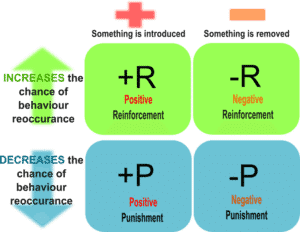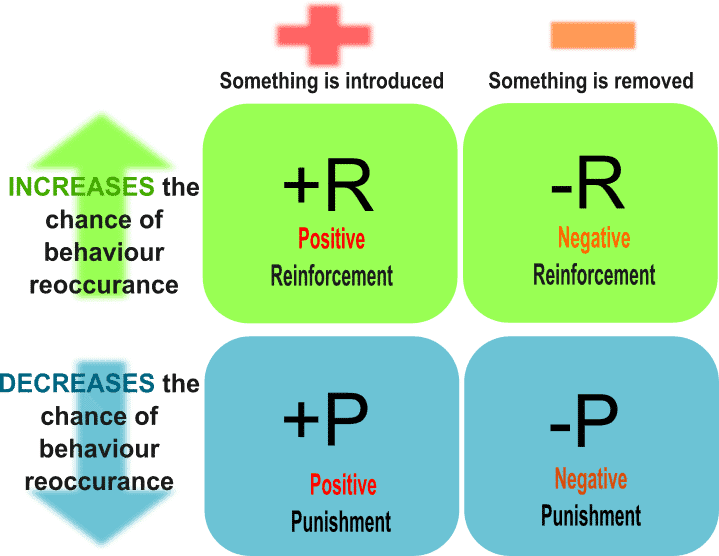HOW DOGS LEARN
OPERANT CONDITIONING THE SCIENCE BEHIND DOG TRAINING: HOW DOGS LEARN AND ARE TRAINED

HOW DOGS LEARN
At Phoenix Dog Training we use about 90% positive reinforcement and about 10% negative reinforcement. I also use negative punishment which is the removal of something the dog wants to decrease or stop unwanted behavior. An example of negative punishment is to take away your kids WiFi password until they do their homework. You are trying to stop or decrease the child’s procrastination. With a dog it might be removing a treat or a toy. This is one of the many ways how dogs learn.
I personally do not use positive punishment because I do not believe that how dogs learn has to be to experience fear, pain and intimidation to be taught. But I do use negative reinforcement, but in a unique way.
This being the case, Here at Phoenix Dog Training we are always eager to counteract the flashing red lights some people see when they hear the word “negative reinforcement.” Don’t let the term scare you, because in truth it isn’t negative at all! In fact it is non-aversive, as we don’t believe any dog should be trained with fear, pain or intimidation. As an example consider the following:
- I am walking a dog and want to turn right
- The dog wants to continue going straight
- I tap the dog on the shoulder to get its attention so it can turn with me
- I stop tapping on the dog’s shoulder when the dog performs the wanted behavior.
HOW DOGS LEARN
That is all there is to negative reinforcement! People often confuse negative reinforcement with punishment. the two are not the same. Negative reinforcement increases and or strengthens behavior. Punishment stops or decreases a behavior.
Traditionally, how dogs learn and the use of negative reinforcement has been to apply an unpleasant stimulus to the dog, and then help the dog to do the behavior in order to remove the unpleasantness. The dog works to turn off the unpleasant stimulus, or to avoid it all together. Different trainers will use negative reinforcement differently. How unpleasant the stimulus is varies from trainer to trainer.
My experience and work with how dogs learn has shown me that negative reinforcement really does not need to be a true aversive. To me when I think aversive, I think pain or unpleasant. In fact, here is the dictionary definition of aversive:
” aversive. adjective. Causing avoidance of a thing, situation, or behavior by using an unpleasant or punishing stimulus, as in techniques of behavior modification.”
I have personally developed a system based on how dogs learn and the use of negative reinforcement that uses a non aversive tactile or touch sensation that is nuetral. The tactile or touch sensation is not unpleasent, demonstrated by the dog’s behavior, there is no avoidance. The tactile or touch stimulus becomes a tactile cue, prompt, or command that is paired with both auditory and visual cues, adding another layer of communication to both verbal commands and hand signals. I use multiple modalities of communication with dogs for more complete understanding and clarity of communication.
What the dog experiences is very light non aversive tapping on its neck while being given a verbal command along with a visual command (hand signal.) When the dog does the behavior, the light tapping stops. Rather than being an aversive, it is neutral touch, or a non painful tactile touch.
I have seen mothers speaking to their children who did not respond to them, touch the child on the shoulder to get the child’s attention with light touch and to get them to follow through on what the mother was asking. That is non aversive negative reinforcement.
Another example of non aversive negative reinforcement that people experience is the seat-belt indicator. If you don’t put your seat-belt on, there will be a sound going off or a light going off until you fasten the belt. Once you do the behavior, the sound goes away. There was no pain, at most it was an annoyance.
HOW DOGS LEARN
There are total positive reinforcement only trainers that can not conceive of non aversive negative reinforcement. They like to say their way of training is scientific, but they fail to discuss ALL of the science. The total positive reinforcement trainers want to claim how dogs learn is only with positive reinforcement. They refuse to correct a dog. One of the reasons they can not conceive of non aversive humane negative reinforcement is because they have ZERO experience with it. They are giving their opinion on something that they have never done.
By combining all of the aforementioned aspects of how dogs learn, Phoenix Dog Training Dog Trainers are able to make their intentions clear to puppies and dogs. By opening the lines of communication Phoenix Dog Training is able to provide a low stress atmosphere for puppy training and canine training while getting lasting results in a fraction of the time of other Phoenix dog trainers.
We are committed to how dogs learn and providing dog training in Phoenix that offer the least amount of stress and the quickest results. Remember, we are training you as well as your dog, and the knowledge and insight you’ll gain into your dog’s mind and regarding the techniques with which to communicate your wishes will result in lasting good behavior and a more balanced home life.
Thanks for reading and hopefully you have learned a little something about how dogs learn.
Phoenix Dog Training are the best dog trainers we have found in the Phoenix/Scottsdale area. Their Dog Behaviorist has personally helped us with our dogs as we had a tough case. Our dogs are doing great and we would never go to anyone else to train our dogs. The people, service and knowledge of training dogs is the best we have seen by far! I would recommend them to all my friends and family! Thank you!– Greg and Jody Fossen



